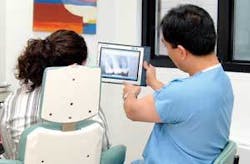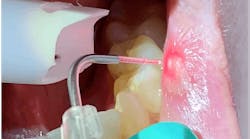Story by E.J. Bartolazo, DMD
Digital radiography is one of the most important new advances that our profession has seen in quite some time. The capability to reduce the exposure of radiation to the patient while increasing our diagnostic proficiency has astounding implications. The reduction of the use of harsh chemicals and other waste materials associated with traditional radiography is also an added benefit to our environment. While the diagnostic benefits of this technology have been written and lectured about extensively, one additional benefit has not really been addressed: Despite its high initial cost outlay, digital radiography is actually quite cost-effective.
An ADA survey puts the materials cost of a single, traditional radiograph at about 50 cents. A typical practice takes approximately 50 films a day, for a daily cost of $25. If you work five days a week and 45 weeks a year like I do, the cost adds up to $6,000 per year. This translates into roughly the entire cost of a basic digital radiography system with one sensor, such as the SUNI System (Suni Medical Imaging, San Jose, Calif.) that we use in our office. Therefore, after one year, the costs have been met for the entire life of the system - and these are materials costs only.
When we factor in labor, it becomes obvious that film-based radiography, being much more labor-intensive than its digital counterpart, will result in higher overall labor costs. Time spent in the darkroom processing film varies, taking anywhere from seven minutes on the conservative side, to 15 minutes for a full-mouth series. The labor cost for a staff member to process, develop, and mount 50 films a day is approximately $50, equivalent to roughly $1,000 per month. Typical lease costs for a basic digital X-ray system are between $400 and $500 per month, so the money saved in labor costs alone is more than enough to cover a monthly lease payment.
The consumables costs are quite significant for film-based radiography. Of course, there are recurring costs that go along with a digital radiography system as well, but not nearly as many as are associated with conventional, film-based systems. For example, with film-based radiography, the expenses add up with the ongoing (and never-ending) purchase of film developer and fixer solutions, film holders, and film itself. There are also costs associated with disposal of the chemical waste generated by processing the film. And as we all know, consumables never generate a return on expenditures, so they are a losing proposition from the start. With a digital radiography system, recurring costs are nominal, and once the system is paid for, it costs very little to operate on a daily basis. Just about the only consumables associated with digital radiography are the protective barrier sleeves that fit over the sensors. Beyond that are photo paper and printer ink, but these items are an issue only in instances when you need to have a physical printout of a particular X-ray, which isn’t often in this digital age. Digital X-rays are quickly and easily transmitted to insurance companies or other dentists via e-mail - no paper (and no postage!) necessary.
There are additional savings that are not fully realized until the office has made the switch to digital radiography. For example, you no longer need room to store radiographs and unused film. If you incorporate digital radiography into a “paperless office,” you don’t need the physical space to store charts. This is a huge advantage in locations where the cost of office space is astronomical, such as Manhattan where I practice.
The reduction of chemical waste is also a big consideration. We pride ourselves in being “green,” that is, environmentally responsible. The elimination of the chemicals associated with radiography as well as the reduction in the use of radiation are cost savings that not only hit closer to our pockets, but also work to the benefit of our environment and our patients.
Digital radiography systems reduce radiation exposure to patients by up to 80 percent compared to film-based systems. Although there is no question that contemporary, film-based radiography systems are indeed exceptionally safe, digital radiography conforms to the very important ALARA principle: As Low As Reasonably Achievable. This is a radiation safety principle for minimizing radiation exposure to both patient and operator by employing all reasonable means possible. ALARA mandates that every possible method of reducing exposure to radiation should be used to minimize risk for the patient and operator alike; digital radiography conforms to this principle right out of the box.
Unlike film, digital X-ray images can be enhanced to assist in making a precise diagnosis. Images can be magnified, sharpened, colorized, or displayed as a negative. These software-controlled enhancements optimize the image but do not alter the data - you can always “go back” to view the original image. Digital tools such as these are built right into the software that drives the digital radiography system. The X-rays are stored in the patient’s digital file, and can be brought up and viewed instantly at a later date. Another great thing about digital radiography (which is fast becoming a very useful tool) is the capability to superimpose images taken at different times, and then instruct the computer to emphasize or highlight only areas that differ. Think of it as time-lapse photography - you can see change over time. Changes such as tooth movement, bone loss or growth, and even subtle nuances of change in a restoration, filling, or root canal can be quickly and easily recognized using this technique, which is ideally suited to digital radiography.
The most dramatic aspect of digital radiography is the time savings. We all see our practice value affected by how much time it takes to do procedures. Digital radiography is fast. The pictures you take are ready to view in less than one second after shooting. Compare that to the five to eight minutes necessary to develop films for 40 patients, which can add three (or more) hours to production and associated costs over the course of one day. That’s equivalent to an entire week each month spent in the darkroom.
One of the main arguments for not switching to digital radiography has been, “I’ve been diagnosing for decades using film, and it works just fine.” While that is true, digital radiography is finally getting the respect it deserves. When digital radiography was in its infancy, there were some issues regarding resolution in comparison to film - side by side, film looked better. But that was several years ago. Digital resolution has increased dramatically to the point where it is equal to or greater than film in regard to image quality. Greater than 20 line pairs per millimeter is typical resolution for film. Most digital radiography systems on the market today display images at an equivalent or greater level of detail.
When the day is done, however, it comes down to dentists providing patients with the highest level of service and care possible. Incorporating cutting-edge technology such as digital radiography into your practice helps achieve this, and it also enhances public perception of your practice. Patients perceive the acquisition of new technologies as dentists caring enough to provide them with the best diagnostic treatment available. This intangible asset cannot possibly be measured in terms of dollars and cents, but you can be certain that your patients will not only be impressed that you are a cutting-edge practitioner, but they will tell their friends and family too.
Dr. E.J. Bartolazo received his bachelor of science degree in microbiology at the University of Florida, Gainesville. He then relocated to Boston, Mass., to attain his dental degree at the Tufts University School of Dental Medicine. Dr. Bartolazo completed postdoctoral residency training at The Mount Sinai Medical Center in New York City, and has been in private practice in New York City for 10 years. Professional memberships include the ADA, First District Dental Society, and the Academy of General Dentistry. You may contact Dr. Bartolazo by phone at (212) 265-3224 or e-mail [email protected].








